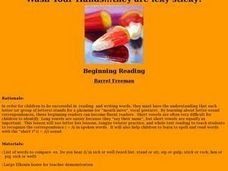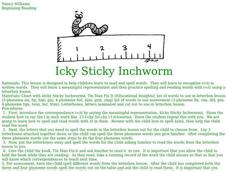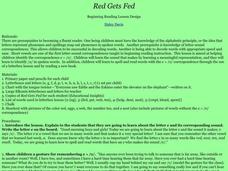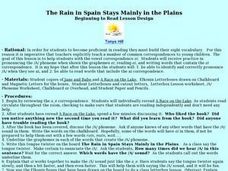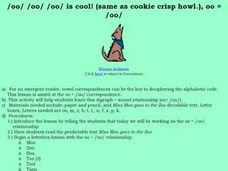Curated OER
Wash Your Hands...they are icky sticky!
Students engage in an emergent literacy lesson that focuses on phonemic awareness and they practice corresponding the letter "i" to its long or short sound. This type of recognition has been found to be essential to reading development.
Curated OER
/o/... I can't stop yawning!
Learners investigate the phoneme, a meaningful representation, and the letter symbol for /o/ (short o). This lesson helps students recognize the /o/ in spoken words and begin to spell words with the assistance of letter boxes. Learners...
Curated OER
The Icky in Sticky
Students study the /i/ sound by listening to it in words and a tongue twister which they later recite. Next, they practice writing the letter and making word using letterboxes. They listen to 'Icky Sticky Inchworm' while placing their...
Curated OER
O-o-o-oh, no-o-o-o!!
Students engage in an emergent literacy lesson in order to practice the skill of phonemic awareness. They learn this skill using the phoneme for the letter "o". Students must recognize the letter as well as its sound.
Curated OER
Shhhhelly Shhhhrimp
Students read and spell words via alphabetic insight that letters stand for phonemes and spelling. They map out the phonemes in spoken words. This instructional activity will help students identify the letters s and h, along with the...
Curated OER
Choo Choo Train
First graders study the sound and spelling of the /ch/ digraph. They repeat words containing the "ch" before making words using their Elkonin letterboxes and letter manipulatives. Next, they clap each time they hear the "ch" digraph...
Curated OER
O-O-O-O-O, I get it!
Students engage in an emergent literacy instructional activity that focuses on the skill of phonemic awareness. To practice the skill the phoneme for the letter "o" is used. The students need to recognize the letter and its corresponding...
Curated OER
"Easy E Street"
Students investigate how the same letter can make more than one sound. It is also important for students to understand that the correspondences can be spelled and pronounced differently. This lesson will review e=/e/ and introduce ee=/E/...
Curated OER
Icky Sticky Inchworm
Use the meaningful example "Icky Sticky Inchworm" to demonstrate the /i/ sound. Then have learners take out letter boxes and spell simple words like six, lip, him, pin, slim, grin, etc.
Curated OER
Shhh!
What sound do fish and ship have in common? Study the /sh/ sound with your young learners. They hear a common tongue twister, spell words in their letter boxes, and read The Rainbow Fish by Marcus Phister to hear the words in context.
Curated OER
Shhhhh, She is Sleeping
The sheep on the ship was shocked by the Fish on the Shore! Can you guess which digraph we're studying? Take a look at the /sh/ sound with your young readers. Have them write words with the target sound in letter boxes, and then small...
Curated OER
Red Gets Fed
Students practice with the strategy that letters represent phonemes and spellings map out phonemes in spoken words. They work on the phoneme sounds of /a/ and e=/e/ in correspondences with reading. Each student also recites the tongue...
Curated OER
The Loud Trout Shouts!
Students practice the strategies of phonemes and digraphs dealing with the correspondence "ou"=/ow/ in both spoken and written words. They listen as the book The Napping House by Audrey Wood is read to them and then they interact with...
Curated OER
Iggy is Icky Sticky
Second graders explore short vowels and their help in the development of phonemic awareness. They gain experience of the correspondence /i/. Students illustrate the correspondence by using memorable techniques used in showing /i/ in...
Curated OER
Howwwwl At The Moon
Students explore vowel digraphs. They discuss what a vowel digraph is and discuss the vowel digraph ou=/ow/. Students read "The Napping House." They practice spelling words with the /ow/ sound in them. Students read words with the /ow/...
Curated OER
Champions of /Ch/
Students identify the digraph /ch/ in written and spoken language. Students practice identifying initial and final placement of the digraph /ch/ in words by identifying pictures containing the sound. They decode and spell words in with...
Curated OER
Ow! That Hurts!
Students identify the diagraph of ow coming together to make one sound. They read words containing this diagraph and spell words too. In the story, The Napping House, each pair of students finds -ow words. As an assessment, students...
Curated OER
The Rain in Spain Stays Mainly in the Plains
Students review the concept of vowel digraphs. They identify the digraph /ai/ in spoken language. After a brief discussion, students apply the rule for reading and spelling words containing the /ai/ digraph by creating a word chart.
Curated OER
Theo and His Thirty Thirsty Brothers
Pupils recognize the digraph /th/ in both spoken and written words. They read and spell words containing /th/ digraph. They read "Changes in Seasons" by Eizabeth Sengel and make a list of the words containing /th/ digraph.
Curated OER
The Ghost Says Boo
Students are introduced to the vowel pattern that produces the /oo/ sound in words. Through matching, listening, and spelling activities, students recognize the phoneme /oo/ and its placement in words. They read a passage with words...
Curated OER
Hi, My Name is A
Students distinguish between short vowel a and long vowel a. They are introduced to the vowel-consonant-e pattern that changes short vowel sounds into long vowel sounds. They practice decoding pseudo words with the vowel-consonant-e...
Curated OER
Here Kitty, Kitty
Students recognize the short vowel i in written and spoken language. Through matching activities, they discriminate the short vowel /i/ from other vowel sounds. Students associate the phoneme with its letter representation and identify...
Curated OER
Cookie Crisp Howl
Students are introduced to the vowel pattern that produces the /oo/ sound in words. Through matching, listening, and spelling activities, students recognize the phoneme /oo/ and it's placement in words. They write a message using words...
Curated OER
Shhh! I'm trying to learn this digraph
First graders identify the digraph /sh/ in written and spoken language. After a brief discussion of the independent and combined sounds of the phonemes /s/ and /h/ students practice identifying initial and final placement of the new...


